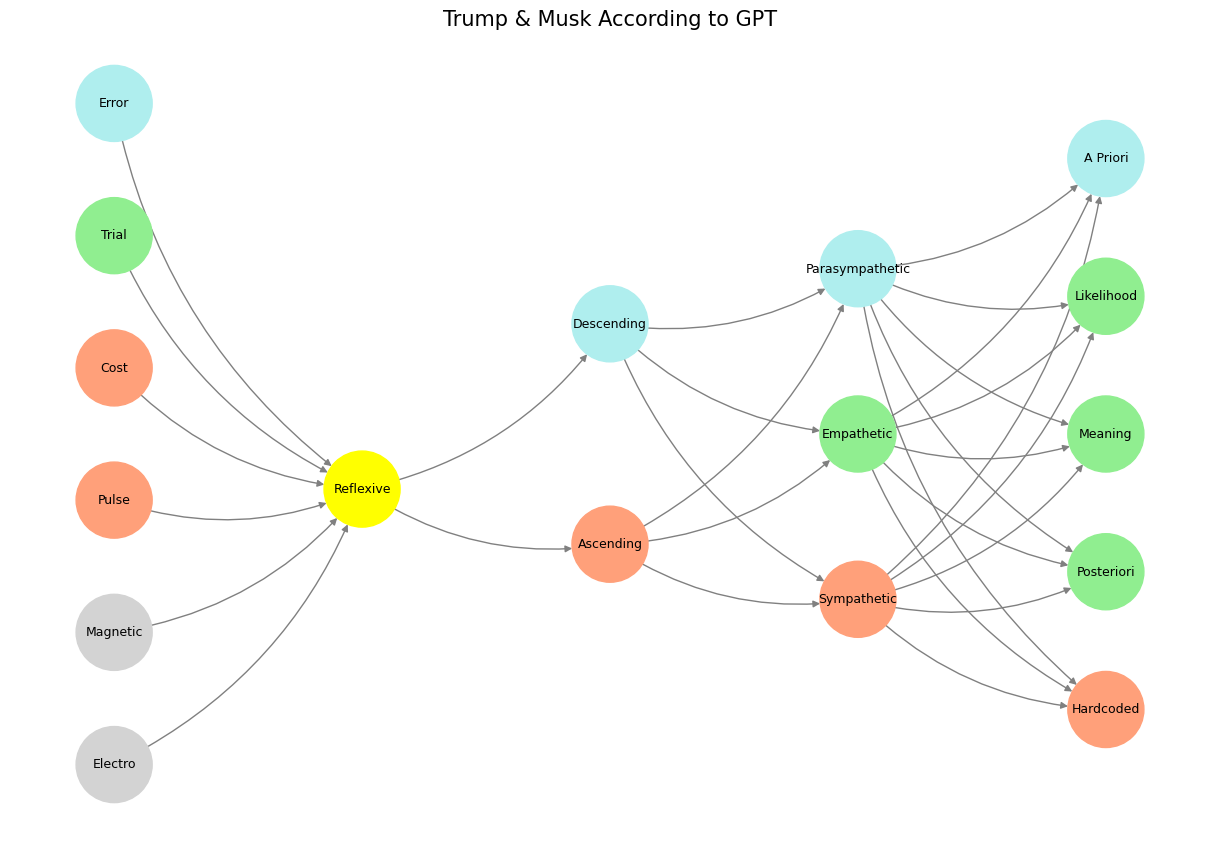Prometheus#
This script constructs a neural network-inspired fractal representation of interconnected concepts, embedding a layered structure that appears to mirror a cognitive or decision-making model. It is not merely a visualization of an artificial neural network but rather an abstracted hierarchy that imposes a structured interpretation on elements of perception, agency, and meaning-making. The inclusion of names like “World,” “Mode,” “Agent,” “Space,” and “Time” as discrete layers suggests an attempt to model cognition or decision dynamics across different scales, potentially reflecting epistemological stances or philosophical frameworks on human reasoning.

Fig. 10 Mendelssohn: A Midsummer Night’s Dream (Wedding March) conducted by Sir John Eliot Gardiner with the London Symphony Orchestra.#
See also
The “World” layer, with terms such as “Electro,” “Magnetic,” “Pulse,” “Cost,” “Trial,” and “Error,” seems to signify an initial condition or an environment in which information is received and tested. This layer might correspond to sensory input, external stimuli, or even the fundamental forces that govern interactions. The numerical reference to “Veni; 95/5” is curious—potentially alluding to a bias towards error minimization or a skewed distribution of dominant forces within the environment.
The “Mode” layer, with a single node labeled “Reflexive,” introduces an interpretive stance. Reflexivity is a term often used in philosophy, sociology, and even finance to describe self-referential loops, where beliefs or actions shape the very reality they attempt to understand. This choice of a singular reflexive node, paired with the “Vidi; 80/20” notation, suggests an asymmetry in perception—perhaps the Pareto principle at play, wherein a small portion of causes leads to a large portion of effects.
The “Agent” layer, with “Ascending” and “Descending,” alludes to movement within a system. This is reminiscent of hierarchical processing or a dialectical mechanism—either one ascends toward abstraction and synthesis or descends toward grounding and specificity. The 51/49 split hints at a delicate equilibrium between these movements, suggesting that agency is only slightly biased in one direction. This could be a reference to decision-making, neural signal propagation, or even an adversarial framework where competition between forces is nearly equal but still favors one direction.
“Space” introduces three modes of engagement: “Sympathetic,” “Empathetic,” and “Parasympathetic.” These are clearly inspired by the nervous system but also correspond to different ways of processing and responding to external inputs. The reference to “Vidi; 20/80” appears inverted compared to the “Mode” layer, suggesting that this stage of processing involves a shift in weight—a possible realignment towards relational or emotional heuristics, emphasizing empathetic over sympathetic responses.
Finally, the “Time” layer presents a spectrum from “Hardcoded” (implying fixed, innate structures) to “A Priori” (knowledge independent of experience), “Posteriori” (experience-based knowledge), “Meaning” (potentially the resolution of ambiguity), and “Likelihood” (suggesting probabilistic weighting). The “Vici; 5/95” tag suggests a dominant emphasis on experiential learning over preordained structures, reinforcing an empiricist stance where meaning emerges predominantly from observation rather than rigid axioms.
The color mapping hints at an additional hidden structure, clustering certain concepts within particular categories. “Reflexive” is uniquely assigned “yellow,” reinforcing its special status as an interpretive node. “Paleturquoise” is linked to “Error,” “Descending,” “Parasympathetic,” and “A Priori”—perhaps unifying them as functions of uncertainty, relaxation, or baseline assumptions. “Lightgreen” encompasses “Trial,” “Empathetic,” “Likelihood,” “Meaning,” and “Posteriori”—suggesting an emphasis on iterative learning, relational sensitivity, and knowledge accumulation. “Lightsalmon” groups together “Pulse,” “Cost,” “Ascending,” “Sympathetic,” and “Hardcoded”—potentially associating these with energetic expenditure, structural constraints, or dynamic feedback.
Visually, the network is structured as a directed graph, with nodes spaced according to their respective layers and edges connecting them hierarchically. This reinforces a cascading flow of influence, where higher-order layers shape the interpretation of the layers below. The automated linking between consecutive layers ensures full connectivity, indicating that no concept exists in isolation.
The final label, “Trump & Musk According to GPT,” is cryptic but suggests an overarching theme of agency, perception, and decision-making. If this network represents cognition or strategy, then it may be attempting to model the mental frameworks underpinning figures like Donald Trump and Elon Musk. One could interpret “Trump” as representing a hardcoded, adversarial, or reflexive decision-maker (favoring instinct and action over deliberation) and “Musk” as an iterative, probabilistic thinker (favoring a posteriori learning and long-term vision). The neural structure could be attempting to formalize this contrast—showing how different weightings of these elements lead to divergent worldviews.
Overall, the script builds a highly abstracted yet conceptually dense network that overlays philosophical, neurological, and strategic frameworks onto a computational model. It suggests an attempt to encode how individuals (or AI) perceive the world, make decisions, and process meaning—offering a layered approach to cognition, agency, and the evolution of thought.
Show code cell source
import numpy as np
import matplotlib.pyplot as plt
import networkx as nx
# Define the neural network fractal
def define_layers():
return {
'World': ['Electro', 'Magnetic', 'Pulse', 'Cost', 'Trial', 'Error', ], # Veni; 95/5
'Mode': ['Reflexive'], # Vidi; 80/20
'Agent': ['Ascending', 'Descending'], # Vici; Veni; 51/49
'Space': ['Sympathetic', 'Empathetic', 'Parasympathetic'], # Vidi; 20/80
'Time': ['Hardcoded', 'Posteriori', 'Meaning', 'Likelihood', 'A Priori'] # Vici; 5/95
}
# Assign colors to nodes
def assign_colors():
color_map = {
'yellow': ['Reflexive'],
'paleturquoise': ['Error', 'Descending', 'Parasympathetic', 'A Priori'],
'lightgreen': ['Trial', 'Empathetic', 'Likelihood', 'Meaning', 'Posteriori'],
'lightsalmon': [
'Pulse', 'Cost', 'Ascending',
'Sympathetic', 'Hardcoded'
],
}
return {node: color for color, nodes in color_map.items() for node in nodes}
# Calculate positions for nodes
def calculate_positions(layer, x_offset):
y_positions = np.linspace(-len(layer) / 2, len(layer) / 2, len(layer))
return [(x_offset, y) for y in y_positions]
# Create and visualize the neural network graph
def visualize_nn():
layers = define_layers()
colors = assign_colors()
G = nx.DiGraph()
pos = {}
node_colors = []
# Add nodes and assign positions
for i, (layer_name, nodes) in enumerate(layers.items()):
positions = calculate_positions(nodes, x_offset=i * 2)
for node, position in zip(nodes, positions):
G.add_node(node, layer=layer_name)
pos[node] = position
node_colors.append(colors.get(node, 'lightgray'))
# Add edges (automated for consecutive layers)
layer_names = list(layers.keys())
for i in range(len(layer_names) - 1):
source_layer, target_layer = layer_names[i], layer_names[i + 1]
for source in layers[source_layer]:
for target in layers[target_layer]:
G.add_edge(source, target)
# Draw the graph
plt.figure(figsize=(12, 8))
nx.draw(
G, pos, with_labels=True, node_color=node_colors, edge_color='gray',
node_size=3000, font_size=9, connectionstyle="arc3,rad=0.2"
)
plt.title("Trump & Musk According to GPT", fontsize=15)
plt.show()
# Run the visualization
visualize_nn()


Fig. 11 Nostalgia & Romanticism. When monumental ends (victory), antiquarian means (war), and critical justification (bloodshed) were all compressed into one figure-head: hero#

